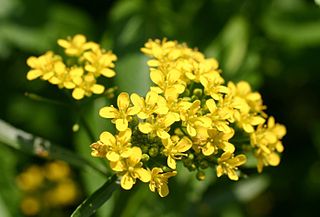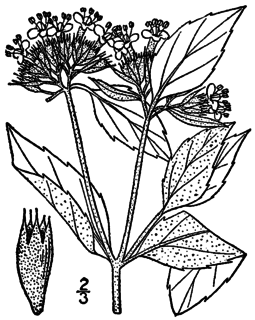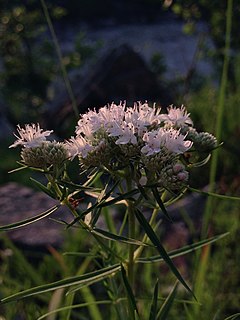
Rorippa is a flowering plant genus in the family Brassicaceae, native to Europe through central Asia, Africa, and North America. Rorippa species are annual to perennial herbs, usually with yellow flowers and a peppery flavour. They are known commonly as yellowcresses.

Monarda is a genus of flowering plants in the mint family, Lamiaceae. The genus is endemic to North America. Common names include bergamot, bee balm, horsemint, oswego tea, the latter inspired by the fragrance of the leaves, which is reminiscent of bergamot orange. The genus was named for the Spanish botanist Nicolás Monardes, who wrote a book in 1574 describing plants of the New World.

Jeholornis is a genus of avialans that lived between approximately 122 and 120 million years ago during the early Cretaceous Period in China. Fossil Jeholornis were first discovered in the Jiufotang Formation in Hebei Province, China and additional specimens have been found in the older Yixian Formation.

Pycnanthemum incanum, with the common name hoary mountainmint, "mountain mint", wild basil or hoary basil, is a herbaceous perennial in the mint family.
High Mountain Park Preserve is a protected area of the Preakness Range of the Watchung Mountains in Wayne, New Jersey, United States. Established in 1993, it comprises 1,153 acres (5 km2) of woodlands and wetlands owned and managed by The Nature Conservancy.
Grevillea humifusa, also known as spreading grevillea, is a prostrate shrub found only in a localised area in Western Australia and is considered critically endangered in the wild.

Pycnanthemum tenuifolium, the narrowleaf mountainmint, slender mountainmint, common horsemint or Virginia thyme, is a plant in the mint family, Lamiaceae. It is native to eastern North America.

Pycnanthemum virginianum, the Virginia or common mountain-mint, is a plant in the mint family, Lamiaceae. It is a herbaceous plant with narrow, opposite, simple leaves, on wiry, green stems. The flowers are white with purplish spotting, borne in summer. Like most plants in the genus, the foliage has a strong mint fragrance when crushed or disturbed. It is native to the eastern United States and eastern Canada.

Pycnanthemum is a genus of plants in the mint family (Lamiaceae). They are commonly known as mountain mints, though "the mountain mint" may also be any locally common species in particular. Some are known as koellias, after an obsolete genus name.

Neyraudia is a genus of Asian and African plants in the grass family.

Phacelia curvipes is a species of flowering plant in the borage family, Boraginaceae, known by the common names Washoe phacelia and Washoe scorpionweed. It is native to the southwestern United States, where it grows in many types of habitat, such as chaparral, oak and pine woodland, and forests.

Pycnanthemum californicum is a species of flowering plant in the mint family known by the common name Sierra mint, mountain mint,, and California mint.
Rorippa curvipes is a species of flowering plant in the family Brassicaceae known by the common name bluntleaf yellowcress. It is native to much of western North America from Alaska to Mexico to the Mississippi River, where it can be found in various types of moist and wet habitat, including lakeshores and riverbanks, meadows, roadsides, mudflats, and irrigation ditches. It is an annual or perennial herb, producing several stems growing prostrate along the ground or somewhat upright, measuring 10 centimeters to around half a meter in maximum length. The leaves are long and narrow, smooth edged or lobed, the lobes sometimes cut all the way to the midrib or separated to form leaflets. Lower leaves are borne on petioles; upper leaves have bases that clasp the stem. The mustardlike flowers have very small yellow petals. The fruit is a plump, hairless silique containing many minute seeds.

The flora of China is diverse. More than 30,000 plant species are native to China, representing nearly one-eighth of the world's total plant species, including thousands found nowhere else on Earth.

Thysanocarpus curvipes is a species of flowering plant in the family Brassicaceae known by the common names sand fringepod and lacepod. It is native to western North America from British Columbia through the western United States to Baja California, where it grows in many types of habitat. It is a common plant in much of its range. It is variable in appearance. It is an annual herb producing a branching or unbranched stem 10 to 80 centimeters tall. The leaves are mostly lance-shaped but variable. The lower ones are sometimes borne on petioles and the upper ones may clasp the stem at their bases. They may be smooth-edged, toothed, or lobed. The inflorescence is a raceme of flowers with four white or purple-tinged petals and purple sepals. The fruit is a flattened, rounded or oval disclike capsule with a thin wing around the edge. The fruit is under a centimeter long and the wing is variable in appearance, flat or wavy, sometimes perforated.
The Plant List is a list of botanical names of species of plants created by the Royal Botanic Gardens, Kew and the Missouri Botanical Garden and launched in 2010. It was intended to be a comprehensive record of all known names of plant species over time, and was produced in response to Target 1 of the 2002-2010 Global Strategy for Plant Conservation, to produce "An online flora of all known plants.” It has not been updated since 2013, and is superseded by World Flora Online.
"Wild basil" is a common name for several plants in the mint family (Lamiaceae):

Agalinis skinneriana is a species of flowering plant in the family Orobanchaceae known by the common names Skinner's gerardia, Skinner's false foxglove and pale false foxglove. It is native to North America, where it occurs in Ontario south to Missouri and Louisiana.
Pycnanthemum torreyi, common name Torrey's mountainmint, is a perennial plant native to the United States.
Australian online fauna & flora databases: Both the Commonwealth of Australia and its various states maintain a number of online databases which encompass both native and naturalised fauna and flora. Some are taxonomic. Some are descriptive. Some are both. Some indicate threatened or nuisance species. The list below is incomplete.














